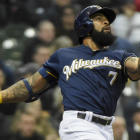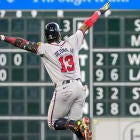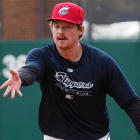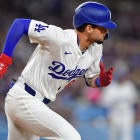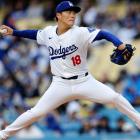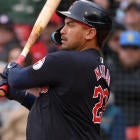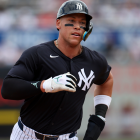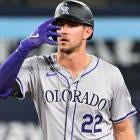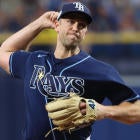More Fantasy Baseball: Hernandez, O'Neill show upside on the wire
"Now you're looking for the secret, but you won't find it because, of course, you're not really looking. You don't really want to work it out. You want to be [cut to black] fooled."
That's one of my favorite closing lines from any movie, spoken with increasing foreboding by Michael Caine. Gives me chills just thinking about it.
But The Prestige was about magic tricks (or rivalry escalating to electromagnetic cloning and literal loss of self – same diff), and so in that context, it makes sense. Better to just sit back in enjoy the show.
With Fantasy Baseball, though, there are actual stakes. Your success depends on getting it right. And so you'd think in that context, a counter perspective would be welcome.
But so often, it's discounted, discredited, even vilified, when most often it's coming from a place of benevolence – or at least obligation – and at no cost to you other than the time spent reading.
So why the negativity? I can think of two reasons:
- You're aiming to disrupt the author's livelihood through a series of calculated subversions, which is sort of the internet's MO in 2018. Still, my mind sees the world too logically to accept this as the reason. More likely...
- Your best, most unexpectedly good performers are like pets you rescued from the waiver wire and nurtured to the point you're invested now, unable to see their warts or to heed those who do. Basically, an attack on them is an attack on you.
You want to be fooled, which makes you a fool deserving of all the pity normally prescribed to them.
So enjoy your gold, fool. But don't say I didn't warn you when you go to cash in.
Tied for second in the majors with seven home runs, Eric Thames pulled this same trick last April, you may remember, before slumping for the better part of the next four months. Yes, he has one of the highest hard-contact rates on FanGraphs, but the same was true for him last year. The biggest change so far is he's selling out for power even more – his line-drive rate collapsing and his pull percentage soaring, which together should condemn him to a subpar BABIP and corresponding batting average.
Of course, the performance stuff doesn't even matter if he continues to sit against lefties... or for every third game regardless, as has been the case even during this hot streak. Everyday duty or something close to it is a prerequisite in most mixed leagues.
Manaea has the sort of changeup that's capable of generating swings and misses, and he has taken to throwing it more this year. You'd think that would lead to more whiffs and strikeouts – things he desperately needed after his disappointing sophomore campaign. Both are actually down this year. At 6.5 strikeouts per nine innings, he's firmly on the pitch-to-contact side of the spectrum, which works for some pitchers, namely those known for coaxing ground balls or weak contact out of hitters. Manaea is exceptional in neither of these ways.
Could he be a respectable Fantasy option, better than he was last year? Yeah, but after four strong starts, three of them seven-plus innings, many would describe him as more.
DJ LeMahieu is in his eighth major-league season and his seventh with the Rockies. So him being almost halfway to his career high in homers (11) less than one-sixth of the way into the season demands an explanation other than "progression" or "favorable venue." He is pulling the ball more and hitting it in the air more, but we're talking marginal gains for a player who did little of either in the first place. And here's the weirdest part: all five of his home runs have come away from Coors Field.
I can't make any sense of it, so I'm thinking it's one of those situations where the simplest explanation is the right one – i.e., it's early-season noise. He's a good player, but not this good.
With three consecutive quality starts in which he has recorded at least a strikeout per inning, Vince Velasquez is back on the mixed-league radar, but the same issues that sidetracked him last year are just as present today. Basically, he's too fastball-reliant. It's a great pitch, but it's one he has to throw two-thirds of the time because everything else is no more than show-me. And with so little deception to his arsenal, he's not actually missing many bats, his swinging strike rate ranking in the middle of the pack.
Velasquez can improve on last year's numbers simply by throwing more strikes and maybe deserves to be more than 50 percent owned in CBS Sports leagues, but I don't see huge breakout potential for him with his present arsenal.
The narrative says Dansby Swanson got too pull-happy last year, doing most of his damage on inside pitches, and worked with hitting coach Kevin Seitzer to change his approach on pitches out over the plate. But he's actually pulling the ball more this year. Going the opposite way more, too, so it's true he has made himself a little harder to defend. Not so much he should have a .440 BABIP, though.
He's putting the ball in the air more, which is good, but his line-drive rate was already on the high side last year and he actually has a lower hard-contact rate this yer. The strikeouts are the same, the walks actually down. Swanson may have benefited some from his work with Seitzer, but it seems to me an unsustainable BABIP has carried him thus far.
How exactly is a pitcher with a 4.42 ERA fooling anyone? Well, it could be worse. With all the home runs Steven Matz has allowed, his FIP (a form of expected ERA) is 5.62. He actually had a lower FIP last year, when his actual ERA was 6.08 and he was an unmitigated disaster. Still, given that he has 11.3 strikeouts per nine innings, he has plenty of owners believing the best is yet to come.
His best strikeout effort, though – April 7 at Washington, when he struck out eight in five innings – was a gift from home plate umpire Marty Foster, who awarded Matz an outrageous 30 called strikes thanks to a generous inside corner. Only twice in that game did the Nationals swing and miss, and he hasn't come up with another a swing-and-miss pitch since abandoning his slider after his rookie season. There's more downside than upside here.
Thing is Jed Lowrie was the No. 10 second baseman in Head-to-Head points leagues and No. 21 in Rotisserie as a mere 14-homer man last year, so it's possible he was undervalued to begin with, his inconsistencies and propensity for injury artificially lowering his stock.
But if he had half as many home runs as he has right now, he'd still be ahead of pace. His carer high is 16, and he's 34 years old. He's putting the ball on the ground much more than he did a year ago, costing him both line drives and fly balls, so a power increase is about the last thing we should be seeing from him right now. Don't get too attached.
By now, you probably have an inkling what I'm going to say about Chris Stratton: "not enough missed bats." His eight strikeouts in seven innings Wednesday might mean something if they weren't the result of only seven swinging strikes. What about his 13 swinging strikes he had over seven one-hit innings against the Padres last time out? OK, but that's the aberration, and it still resulted in just four strikeouts to three walks.
Stratton may be able to keep his head above water, but he doesn't have a good enough secondary pitch to excel in this league, and seeing as he has allowed a 29.7 percent line-drive rate, it's a wonder he could one-hit anybody. The highest line-drive among qualifying hitters last year was Daniel Murphy at 27.6 percent. To put it another way, Stratton profiles as a high-BABIP pitcher, and right now his is an outrageously low .231.




























